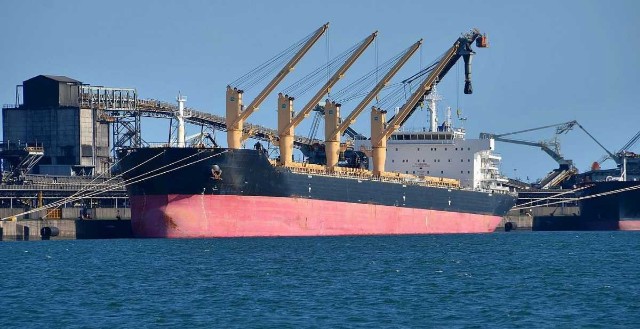Trade routes reset and reshaped

Supply chain snarls and the war in Ukraine will change cargo flows
Both dry and liquid bulk shipping markets will be reshaped this year on the back of supply chain friction and the war in Ukraine, while supply chain problems are expected to “drag on through” 2022.
Analysts at ING expect trade growth of between 1% and 2%, but with notable differences in dominant good flows. “The general trade outlook has deteriorated because of the war, but there are also mitigating effects as commodity flows are being redirected and routes are reshaped which is expected to turn into more tonne-miles. How this plays out for shipping companies largely depends on specific markets and contracting,” said Rico Luman, senior sector economist, Oleksiy Soroka CFA, senior high yield credit strategist, and Inga Fechner, senior economist, Germany, Austria, at ING.
ING examined the replacement of commodity flows running from Russia to Europe and found that coal (EU + UK imported 87 million tonnes in 2021) is the dry bulk flow to Europe most exposed to redirection in the short term. “The EU sourced 46% of its coal imports from Russia and from August onwards these imports will be banned. Alternative imports are expected to come from the US, Colombia, South Africa and Australia,” said ING. These alternative sources will require significantly longer sailings. As well as replacing traditional Russian coal supply, there will also be additional shipments of coal to help reduce gas dependency on Russia, further boosting seaborne coal volumes.
Closing oil taps
Regarding oil flows, the EU + UK imported 172 million tonnes from Russia in 2021, with Russia covering 12% of the global seaborne oil trade. As the EU looks to lessen its dependency on Russian oil it could look to the Middle East for a comparable swap-in said ING, while other countries such as India and perhaps China may open the taps more and welcome additional Russian oil. “This will lead to substantial shifts in trade flow patterns in tanker shipping and more tonne-miles,” noted ING. “Although crude oil trade is expected to stick below pre-pandemic levels, oil and oil product volumes could see an increase of 3-4% with tonne miles going beyond that level because of the reshaping of Russian oil routes.”
The EU + UK imported 78 million tonnes of LNG in 2021, meanwhile, which could be replaced by US exports. The US has committed to ramping up deliveries to Europe by 15 bcm per year in 2022 and 50 bcm in 2030. ING noted that Qatar and Australia could also possibly supply extra LNG, albeit that spare supply of LNG on the spot market is limited. Diverting supplies from delivery via pipeline to seaborne trades will benefit LNG shipping demand over the coming years, however there are ship supply hurdles standing in the way of this growth.
The global fleet of LNG carriers was 681 in 2021 and around 200 vessels are currently on order. But these will take some years to be delivered, with only 8bcm of additional capacity expected this year and next. “If we take an average of seven loops per vessel per year, this would offer an extra annual capacity of 54 bcm on a global scale by the end of 2023,” ING calculated. As a result, limited extra supply and limited extra ship capacity means that additional LNG imports will be curtailed in the short term.
Although crude oil trade is expected to stick below pre-pandemic levels, oil and oil product volumes could see an increase of 3-4% with tonne miles going beyond that level because of the reshaping of Russian oil routes
Uneven playing field
The analysts noted that the impact of the war in Ukraine on shipping companies is unequal on two fronts. Rising bunker costs are one example of that inequality: vessels operating under charter contracts can pass on the fuel bill to the charterer, whereas ships operating on voyage charters are responsible for their own fuel costs. Bunker costs are a sizable proportion of ship operating costs; fuel bills can be as much as half of the total operating costs for larger vessels. “Fuel prices are trading at double the 10-year averages for heavy sulphur fuel oil (HSFO) and have approached 2008 highs for marine gasoil (MGO). Upward price pressure will also remain for some time to come,” said ING.
Additionally, congestion is building up in European ports as they deal with a build-up of containers caused by large carriers suspending Russian-bound services, alongside extra customs checks. This is leading to terminal inefficiency and delays in vessel capacity in Europe.
ING also expects to see more super slow steaming after the market has eased to offset fuel costs in 2022 and 2023, which may push up freight rates. This will be exacerbated by limited capacity to expand the fleet with a predicted fleet expansion of 2.8%, 3.5% and 3% for the bulk carrier, tanker and container fleets respectively. “All in all, fleet expansion will remain limited across shipping segments in 2022 so this won’t derail the markets from the supply side,” said ING, adding that the IMO’s upcoming efficiency requirements will force more recycling from 2023 onwards.
Shifting trade lanes and sourcing of commodities as a direct result of Russian sanctions and the war in Ukraine will play to the strengths of many shipping sectors, but the benefits will be skewed depending on where stakeholders sit in the commodity supply chain.
Auther By Carly Fields
